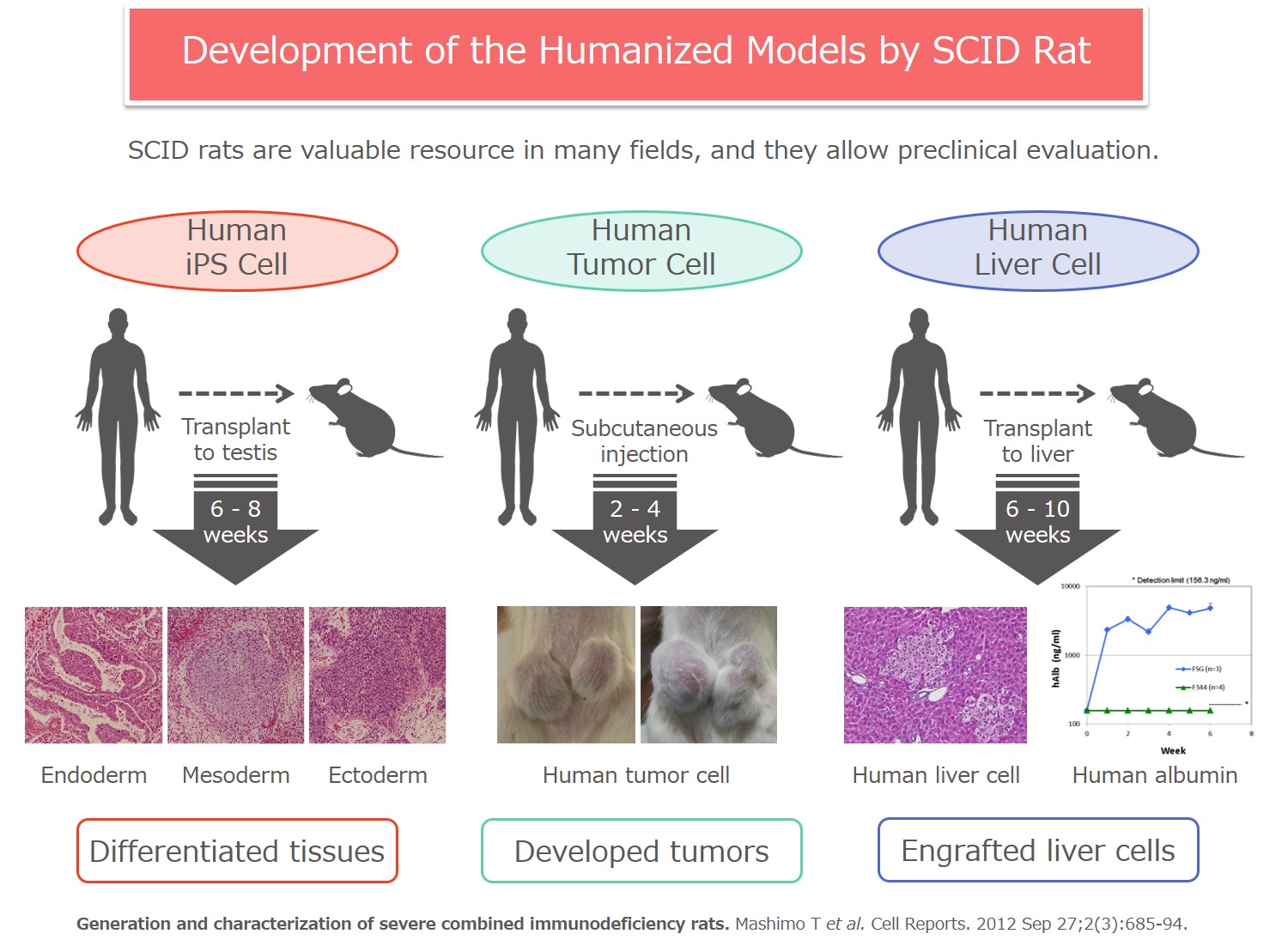Severe Combined ImmunoDeficiency (SCID) Rat
Accelerate Translational Research and Regenerative Medicine
 Nowadays, the technologies of genome editing enable us to generate various animal model.
Different from mice, the laboratory rats have larger size and more relevance to human diseases and attract more attention in many fields, such as Pharmacology and Toxicology.
Among numerous rat models, the immunodeficient rats have large applicability and potential in the researches of multiple are, including cancers, stem cells, organ transplantation, etc.
Nowadays, the technologies of genome editing enable us to generate various animal model.
Different from mice, the laboratory rats have larger size and more relevance to human diseases and attract more attention in many fields, such as Pharmacology and Toxicology.
Among numerous rat models, the immunodeficient rats have large applicability and potential in the researches of multiple are, including cancers, stem cells, organ transplantation, etc.
Rat Strains
We provide three SCID Rat strains. All of these rats are bred at exclusive SPF room, which can be used safely. If you have any questions or something you don't understand, just let us know anytime.
| NBRP Rat No. | Strain Name | Characteristics | Genotyping* |
|---|---|---|---|
| 0883 | F344-Il2rgem1Iexas | This strain shows severe combined immunodeficiency (SCID) caused by 5-bp deletion in Il2rg gene on the X chromosome.This strain grows normally under SPF condition. | (Target) Il2rg (Product Size) Wild Type : 292 bp, Mutant : 287 bp, (Primer) TTGCTGACTTCTATGGACCTTAAA, TTCATCTGGTCTGAACTGATAACTTAT |
| 0894 | F344-Rag2em1Iexas | This strain shows severe combined immunodeficiency (SCID) caused by 1-bp insertion in Rag2 gene on chromosome 3.This strain grows normally under SPF condition. | (Target) Rag2 (Product Size) Wilde type : 381bp, Mutant : 382bp, (Primer) GGGGAGAAGGTGTCTTACGG, AGGTGGGAGGTAGCAGGAAT |
| 0895 | F344-Il2rg/Rag2em1Iexas | This strain shows severe combined immunodeficiency (SCID) caused by 5-bp deletion in Il2rg gene on the X chromosome and 1-bp insertion in Rag2 gene on chromosome 3.This strain grows normally under SPF condition. The sexual maturation is a bit late. | It can be distinguished by the combination of NBRP Rat No.0883 and 0894. |
Practical Examples

References
A high-quality severe combined immunodeficiency (SCID) rat bioresource. *NEW* Miyasaka Y, Wang J, Hattori K, Yamauchi Y, Hoshi M, Yoshimi K, Ishida S, Mashimo T. PLoS One. 2022 Aug 12;17(8):e0272950. doi: 10.1371/journal.pone.0272950. eCollection 2022. PMID: 35960733
Optimal Organ for Patient-derived Xenograft Model in Pancreatic Cancer and Microenvironment that Contributes to Success. Eguchi S, Kimura K, Kageyama K, Tani N, Tanaka R, Nishio K, Shinkawa H, Ohira GO, Amano R, Tanaka S, Yamamoto A, Takemura S, Yashiro M, Kubo S. Anticancer Res. 2022 May;42(5):2395-2404. doi: 10.21873/anticanres.15718.
Transplantation of a human induced pluripotent stem cell-derived airway epithelial cell sheet into the middle ear of rats. Tada T, Ohnishi H, Yamamoto N, Kuwata F, Hayashi Y, Okuyama H, Morino T, Kasai Y, Kojima H, Omori K. Regen Ther. 2022 Jan 14;19:77-87. doi: 10.1016/j.reth.2022.01.001. eCollection 2022 Mar. PMID: 35097166
A humanised rat model reveals ultrastructural differences between bone and mineralised tumour tissue. Lahr CA, Landgraf M, Wagner F, Cipitria A, Moreno-Jiménez I, Bas O, Schmutz B, Meinert C, Mashimo T, Miyasaka Y, Holzapfel BM, Shafiee A, McGovern JA, Hutmacher DW. Bone. 2021 May 20:116018. doi: 10.1016/j.bone.2021.116018. Online ahead of print.
In vivo regeneration of rat laryngeal cartilage with mesenchymal stem cells derived from human induced pluripotent stem cells via neural crest cells. Yoshimatsu M, Ohnishi H, Zhao C, Hayashi Y, Kuwata F, Kaba S, Okuyama H, Kawai Y, Hiwatashi N, Kishimoto Y, Sakamoto T, Ikeya M, Omori K.Stem Cell Res. 2021 Apr;52:102233. doi: 10.1016/j.scr.2021.102233. Epub 2021 Feb 11.
Assembly and Function of a Bioengineered Human Liver for Transplantation Generated Solely from Induced Pluripotent Stem Cells. Takeishi K, Collin de l'Hortet A, Wang Y, Handa K, Guzman-Lepe J, Matsubara K, Morita K, Jang S, Haep N, Florentino RM, Yuan F, Fukumitsu K, Tobita K, Sun W, Franks J, Delgado ER, Shapiro EM, Fraunhoffer NA, Duncan AW, Yagi H, Mashimo T, Fox IJ, Soto-Gutierrez A. Cell Rep. 2020 Jun 2;31(9):107711
Zonisamide promotes survival of human-induced pluripotent stem cell-derived dopaminergic neurons in the striatum of female rats. Miyawaki Y, Samata B, Kikuchi T, Nishimura K, Takahashi J. J Neurosci Res. 2020 Aug;98(8):1575-1587
Intestinal immunity suppresses carrying capacity of rats for the model tapeworm, Hymenolepis diminuta. Ohno T, Kai T, Miyasaka Y, Maruyama H, Ishih A, Kino H. Parasitol Int. 2018 Aug;67(4):357-61.
Fail-safe therapy by gamma-ray irradiation against tumor formation by human induced pluripotent stem cell-derived neural progenitors. Katsukawa M, Nakajima Y, Fukumoto A, Doi D, Takahashi J. Stem Cells Dev. 2016 Jun 1;25(11):815-25.
Estradiol Facilitates Functional Integration of iPSC-Derived Dopaminergic Neurons into Striatal Neuronal Circuits via Activation of Integrin α5β1. Nishimura K, Doi D, Samata B, Murayama S, Tahara T, Onoe H, Takahashi J. Stem Cell Reports. 2016 Apr 12;6(4):511-24.
Generation of Scaffoldless Hyaline Cartilaginous Tissue from Human iPSCs. Yamashita A, Morioka M, Yahara Y, Okada M, Kobayashi T, Kuriyama S, Matsuda S, and Tsumaki N. Stem Cell Reports. 2015 Mar 10;4(3):404-18.
X-linked severe combined immunodeficiency (X-SCID) rats for xeno-transplantation and behavioral evaluation. Samata B, Kikuchi T, Miyawaki Y, Morizane A, Mashimo T, Nakagawa M, Okita K, Takahashi J. J Neurosci Methods. 2015 Mar 30;243:68-77.
Generation and characterization of severe combined immunodeficiency rats. Mashimo T, Takizawa A, Kobayashi J, Kunihiro Y, Yoshimi K, Ishida S, Tanabe K, Yanagi A, Tachibana A, Hirose J, Yomoda J, Morimoto S, Kuramoto T, Voigt B, Watanabe T, Hiai H, Tateno C, Komatsu K, Serikawa T. Cell Reports. 2012 Sep 27;2(3):685-94
Generation of knockout rats with X-linked severe combined immunodeficiency (X-SCID) using zinc-finger nucleases. Mashimo T, Takizawa A, Voigt B, Yoshimi K, Hiai H, Kuramoto T, Serikawa T. PLoS One. 2010 Jan 25;5(1):e8870.